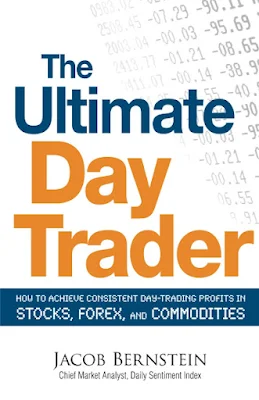The book "The Ultimate Day Trader: How to Earn Constant Day Trading Returns in Equities, Forex, and Commodities" by Jacob Bernstein may be familiar to day traders. This book, written by a seasoned trader, analyst, author, instructor, and system developer, provides a thorough introduction to the art of day trading.
The book covers various aspects of day trading, such as:
- The benefits and drawbacks of day trading
- The day trading's psychological pitfalls and difficulties
- The fundamental methods and tools for day trading
- The day trading order entry tactics and execution techniques
- The day trading risk management and money management principles
- The particular indicators and trading techniques for various markets and time intervals
The book also provides numerous examples, charts, tables, and exercises to help you apply the concepts and methods to your own trading. The book is divided into four parts:
- Part I: The Basics of Day Trading. This section introduces day trading's definition, background, advantages, and disadvantages. The distinction between day trading and other types of trading, such as swing trading and position trading, is also explained. It also covers the psychological aspects of day trading, including self-control, restraint, confidence, and emotional stability.
- Part II: Tools and Techniques for Day Trading. The technical aspects of day trading, including the hardware, software, data sources, brokers, platforms, and order types, are covered in this section. Also, it describes how to study the market and spot trading opportunities using charts, indicators, oscillators, trend lines, support and resistance levels, moving averages, Fibonacci retracements, pivot points, and other tools. Also, it demonstrates how to employ a variety of order entry techniques, including market orders, limit orders, stop orders, trailing stops, OCO orders, bracket orders, and conditional orders.
- Part III: Risk and Money Management for Day Trading. The financial components of day trading, including capital needs, margin requirements, commissions, fees, taxes, and slippage, are the main topics of this section. It also demonstrates how to control risk by calculating it using different techniques, including position sizing, risk-reward ratio, maximum drawdown, expectancy, and Kelly criterion. It offers advice on how to create reasonable objectives and assess success using measures like profit factor, Sharpe ratio, R-squared, and return on account.
- Part IV: Trading Systems and Strategies for Day Trading. This section offers a number of tried-and-true trading methods and approaches for various markets (stocks, currencies, and commodities) and time frames (intraday and daily). It also demonstrates how to create your own trading system utilizing a methodical process that includes system testing, optimization, validation, and implementation. Also, it provides a list of frequent errors and hazards that traders should avoid when creating and implementing trading systems.
The book is appropriate for both new and seasoned traders who wish to learn more about day trading or enhance their abilities and performance. The book is written in a simple, direct manner that makes it simple to comprehend and follow. The author's extensive market expertise is reflected in the book's abundance of useful suggestions and insights.
You can get this book through the link below:

